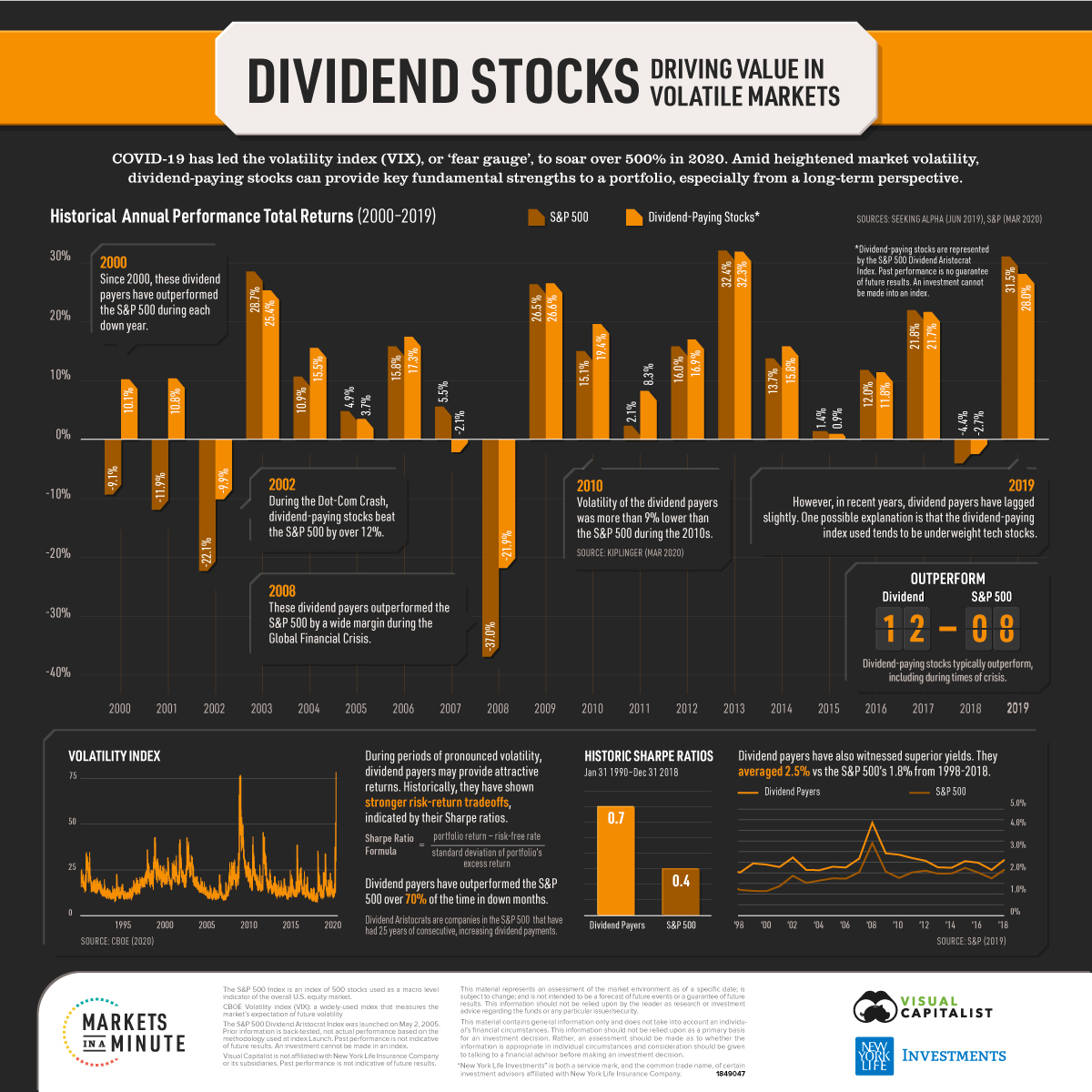This Markets in a Minute Chart is available as a poster.

This Markets in a Minute Chart is available as a poster.
Dividend Stocks: Driving Value in Volatile Markets
When markets take a turn for the worse, dividends often can provide a buffer against the drop.
Year after year, dividend-paying companies put money into shareholders’ pockets—and may offer much needed stability during periods of high volatility. Dividend investing can help offset unexpected downturns by generating a key source of income.
In today’s Markets in a Minute chart from New York Life Investments, we explore how dividends can help lower risk within investors portfolios when markets enter turbulent territory.
The Appeal of Dividends
Over the last two decades, dividend-paying companies have outperformed the S&P 500 in 12 of 20 years, including in all five years where the S&P 500 finished the year in negative territory.
| Year | S&P 500 Total Return (TR) | Dividend-Paying Stocks* Total Return (TR) | Top performer |
|---|---|---|---|
| 2000 | -9.1% | 10.1% | Dividends |
| 2001 | -11.9% | 10.8% | Dividends |
| 2002 | -22.1% | -9.9% | Dividends |
| 2003 | 28.7% | 25.4% | S&P 500 |
| 2004 | 10.9% | 15.5% | Dividends |
| 2005 | 4.9% | 3.7% | S&P 500 |
| 2006 | 15.8% | 17.3% | Dividends |
| 2007 | 5.5% | -2.1% | S&P 500 |
| 2008 | -37.0% | -21.9% | Dividends |
| 2009 | 26.5% | 26.6% | Dividends |
*Dividend stocks represented by S&P 500 Dividend Aristocrat Index. Past performance is no guarantee of future results.
What sets dividend-paying companies—and especially those that continually grow their dividends—apart from the herd?
Wide Moats: A Competitive Advantage
While dividend growth signals company strength, it can also indicate that the company has an economic moat—a sustainable competitive advantage. This means two things: the company can raise prices, and keep competitors at bay. For shareholders, this signals a stronger likelihood of profitability, and more sustainable dividend payouts.
Reinvested Income Fuel Returns
Between 1926 and 2018, reinvested dividend income accounted for 33% of total equity returns in the S&P 500.

While capital appreciation is an undisputed factor in building wealth, it’s easy to forget the sheer force of dividends.
Strong Balance Sheet
A company’s ability to pay steady dividends is critical. Dividends are drawn from a company’s cash balance, which must be sufficient during both strong and lackluster financial conditions.
Ultimately, this cash allocation represents a conservative and disciplined approach to the company balance sheet—demonstrating a commitment to shareholders.
“At the end of the day, dividends are not being paid with margins; dividends are paid with earnings per share.”
—Joe Kaeser
Cushion Against a Shock
When markets turn sour, income from dividend payouts can offer a key lifeline.
The ability for dividend payers to generate superior risk-adjusted returns is demonstrated across their Sharpe ratios, with a higher number indicating a more attractive risk/return profile.
For instance, between 1990-2018, The S&P 500 Dividend Aristocrat Index—a basket of stocks that have paid consistent, increasing, dividends over 25 years— averaged a Sharpe ratio of 0.7 compared to the S&P 500’s 0.4.
Alongside this, a number of dividend payers have outperformed the S&P 500 in every down year since 2000.
| Year | S&P 500 Total Return (TR) | Dividend-Paying Stocks* Total Return (TR) |
|---|---|---|
| 2000 | -9.1% | 10.1% |
| 2001 | -11.9% | 10.8% |
| 2002 | -22.1% | -9.9% |
| 2008 | -37% | -21.9% |
| 2018 | -4.4% | -2.7% |
| Total Years Dividend-Paying Stocks (TR) Outperformed | 5 |
*Dividend stocks represented by S&P 500 Dividend Aristocrat Index. Past performance is no guarantee of future results.
Even during dismal years, dividend payers have shown notable returns.
A Powerful Tool in Today’s Market
As COVID-19 continues to drive further volatility in the market, dividend investing may offer investors both stability and strong income to help weather the storm.
Of course, not all dividend-payers can be expected to be winners. Careful analysis of financial statements and management track records is required to identify companies with the strongest fundamentals.
While dividend payers can help provide a shield in volatile markets, they double as a significant driver of wealth creation over time.



